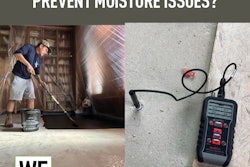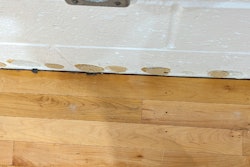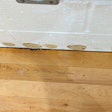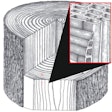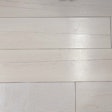
Before I begin explaining how I did find the water in this inspection, to the floor pros contributing online after reading “Wood Floor Mystery #16: It’s Cupping, But There’s No Water Here, Part 1”, let me say that the Fellowship of the Wood Floor Brilliant is strong! I would like to answer some of your questions you left online in this post, but it would likely turn this blog into a dime novel. I hope the next paragraphs answer all your questions, as I did take them into account. Thank you all very much!
And so, without further ado … “Let’s get to it!”
In Part 1, we learned that this flooring was cupped and gapped, but neither the builder nor I could find water present anywhere. I believe the entire hardwood flooring universe agrees that only excessive moisture-related issues could be the cause of all this. Let’s pick up where we left off …
My infrared thermal imaging camera had indicated there were some notably cold sections of the floor. This often indicates that moisture is present. I typically use several meters, both analog and digital, to verify this.
I had only one smoking gun: the crazy spot with the unusually high moisture content located 47 inches from the sliding glass door. Sliding my meters in a radial pattern away from that spot, I could pick up trails where moisture could be migrating. This often may reveal areas with more obvious moisture source, like a leaky appliance or broken pipe.
RELATED: Wood Floor Cupping: Why Does it Happen & What Can You Do?
The meters did, in fact, show a pattern that spread moving away from The Spot, where eventually the area metered at acceptable MC in all directions. There was only that one small spot out of normal range—so why so much damage?
The Spot had something to do with all of this, that I felt sure of. If there were standing water anywhere, then gravity should send it down toward the basement. I measured the distance from the spot to the sliding door so I could see if anything telegraphed to the basement. Oddities and anomalies of various types often leave clues in areas directly below and usually provide more information.
When I transferred the 47-inch measurement in the basement from the sill plate directly below the sliding glass door, there was finally a clue, and it was almost dead on the mark. The drop ceiling tile had water stains. There were no other water stains in the entire basement.
Aha, I found it! Nope. Certainly this was (more) evidence of water, but no actual water dripping anywhere.
There was a small keyboard with a piano bench directly under the stains, and since no one had a ladder, the homeowner let me use the bench. I climbed up and slid back an acoustical tile, and the stained area was, in fact, wet. Not damp … wet.
AHA! I foun… Nope. The tile WAS wet, but I was expecting to find water dripping from the subfloor like it always does, and yet ... the pink fiberglass insulation above the tile looked just fine, so I checked the plywood subfloor and that was absolutely soak...
Nope. No, it wasn’t. I was sure it would be, but it was pristine. Like the reader, I was thinking, “What the …?!” This should have been a no-brainer, but it wasn’t.
I was going to grab my subfloor-calibrated meter to measure the MC of the plywood, but I decided since I was already itchy, dirty, sweaty and blinded by falling ceiling debris, I might as well pull down the insulation first and get a better look.
Appropriately for our climate, the insulation was installed pink-fluff-side down, with the paper/asphalt face stuffed up against the subfloor and held in with wire insulation supports. I began to pull down the insulation, and the entire system: bay, insulation, joists, plywood, flooring staples, all of it looked spotless and dry and …
NOPE!
And that’s when I found the water, my friends! Eureka! “Hallelujah! Holy @#$! Where's the Tylenol?” Just when I thought there was nothing there, filthy, black, disgusting water poured all over my head, down my shirt, into my mouth and eyes, and splashed onto the keyboard keys and the bench I was standing on. I spit into my shirt sleeve repetitively. It was gross.
Thankfully, I thought to grab my cell phone and take photos. I stood on my tippy toes on the rickety bench, jamming my cell phone into the joist bay just clicking away blindly. I’m no ballerina! Balancing, spitting, blinking and itching is no way to snap photos.
Fortunately, one of the photos was clear enough, well, sort of, to capture my little sludge creek:
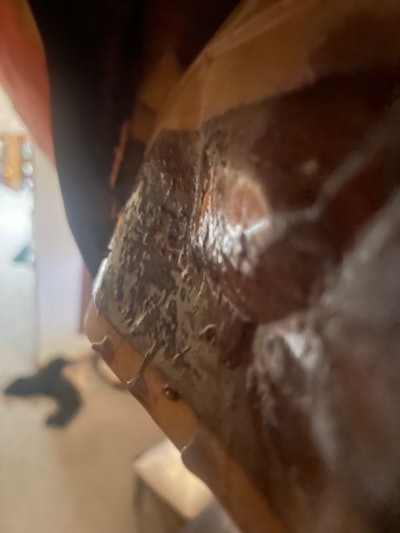 When I pulled the fiberglass insulation down, I was doused with disgusting black water in my face and down my shirt; this is the best shot I could get of it hanging down from the basement ceiling.
When I pulled the fiberglass insulation down, I was doused with disgusting black water in my face and down my shirt; this is the best shot I could get of it hanging down from the basement ceiling.
I have more photos, but they looked like I was caught on body-cam wrestling an pink alligator. They looked like those crappy out-of-focus bigfoot photos, but at least I have evidence and a witness. WATER! We have BINGO!
So what was going on? The water had been pooling and traveling on top of the insulation much like filling an ice cube tray. The paper seam had channeled the water:

It only followed that one joist bay, which explains why the cupping ran specifically from front to back and faded left and right.
The dirty water explained the “musty” smell, although most old basements around here smell like that. Still, where was the water coming from? Maybe a water pipe? And why was the plywood spotless?
I followed the joist bay toward the slider and the outside deck at the back of the house and found water was coming in from above and traveling above the vapor barrier and below the subfloor. It never actually soaked the subfloor; it was the water vapor that caused the cupping.
RELATED: What Lies Beneath: How I Prevent Moisture Problems Before the Sale
I went back upstairs and outside to the deck. Above the slider was a rain gutter, but it stopped 5 feet short of covering the deck, leaving the last 5 feet of the deck and exterior wall unprotected.
On the exterior wall behind the kitchen, directly below the gutter-less roof section, next to the slider, the siding was lime green. It was moldy, mossy, and filthy. You could put your finger through the clapboards.
I showed the homeowner the water in the basement and the rotted wall, and that’s when this very nice lady told me the reason for the kitchen remodel was that they had water coming in from the back of the house, and it had caused extensive damage. She was told it had been rectified.
I bet, if 100 inspectors went in there, they would all be looking for water, and I bet all 100 would have found it eventually. Couldn’t someone have mentioned the existing water issue BEFORE the inspection?! No wonder the builder never joined me and was not surprised when I told him what I found. They knew it was a water problem all along but needed me to prove it. Did they think if I couldn’t find water, I would give them a new floor?
RELATED: Moisture Testing 101: How To Do It Right On Every Job
Lastly, this would explain the floor swelling and shrinking in cycles. I asked if the cupping was more visible during rain or when snow was melting, and the very nice lady caved a bit and admitted that might have been the case. Ugh.
I packed my gear and politely thanked them for their time. At least it was water and not my flooring (almost never is). Before I left their driveway, I called the builder and told him about the water. He said: “Hey, I agreed with you. I told her it was water; we just couldn’t find it.” Is what it is.
Wrapping it all up, you have to assume the rainwater had been splashing under the slider threshold and lower track and found a path into the joist bay. That’s common and would explain the cold temp readings from the slider to The Spot. Migrating water likely pooled well below the range of my meters and probably dried up in most areas when the rain subsided and the heat was operational.
The infamous “Spot” was likely the area where the water pooled the most, dried the slowest, and was closest to where the water was coming in.
I did offer to recommend a qualified flooring contractor and discount any materials they may need. I offered to write a report for their insurance company if they felt it might be covered on their policy. I felt bad for everyone involved. It was a beautiful new floor, and the installation and finishing were excellent—what a shame.
Just telling this story makes me feel like I need a tetanus shot before I write again, but suffice it to say, there is always a flooring mystery brewing out there somewhere. If you got one … share it. We’d be glad to hear from you.
Thank you to all the great floor pros who jumped online and contributed. Our fellowship of floor pros is awesome! To floor pros around the world keep doing what you do so well and remember: The floor always tells the story.
Until next time, stay cool.
See all of Stephen Diggin's popular blog posts and magazine articles here.















